by Dolphine Anyango, Kenya (ELP 2016)
The Food and Agriculture Organization (FAO) defines urban agriculture as the practice of cultivating, processing and distributing food in or around a town or city. This can involve animal husbandry, aquaculture, agroforestry, beekeeping and horticulture. As we toured the three farms, some commonalities become evident. The individuals running the farms have great passion and inject energy into the limited urban spaces. Application of inorganic agrochemicals is frowned upon - they solely depend on animal manure and organic compost which is processed on the farms. Space is not their only limitation; they operate a shoe-string budget and rely heavily on volunteers who spend hours tending to the plants and animals. This is a true case of picking the low hanging fruits and starting with whatever little resources one has at their disposal. Species diversity is evident in the kaleidoscope of colors of flower blooms and the aroma of different herbs and fruits drifiting in the air. Different animal sounds break the afternoon calm from time to time. The animals include chicken for meat and eggs, goats for meat and milk and honey bees.
A myriad of gains exist for community members in these urban farms. They tend to the plants and animals and the sense of ownership is enviable. Volunteers dot the farms and are involved in different activities including tilling, planting, watering, weeding, harvesting, and preparing meals. At the Urban Adamah, a group of teenagers are busy preparing lunch using freshly picked produce from the farm! The farms also serve as training centers where both children and adults are taught various farming techniques using a hands-on approach. The farms provide employment opportunities to community members too. Community members understand and appreciate the fact that mother nature has to be respected and treated well. Vulnerable members are allowed to harvest whatever farm produce they may require and this contributes to community health and social justice. Surplus produce is sold in the neighborhood farmer's markets and the income is ploughed back to run the farm's activities. The farms also grow a variety of medicinal plants. At the City Slickers, there is a beehive of activity as the community members prepare for a party. Such activities enhance social ties. The children acquire skills and knowledge on growing their own food and the significance of a healthy diet. The homeless members also find a space where they can get a square meal from time to time and also get an opportunity to volunteer and give back to society! We meet a small woman who was once homeless but now lives in a small "green house" next to the main gate. The farm has restored meaning to her life. She shuts the farm gates in the evening and opens them in the morning, cleans the washrooms and sweeps the compound to earn some money for her basic needs. Getting three square meals every day is no longer an uncertainty in her life. The ecological benefits of urban farms cannot be overemphasized! There is biological control of pests and the farms contribute to reduction in the community carbon footprint since the plants act as carbon sinks. Food is locally available thereby reducing emissions and energy costs from vehicles that transport food for long distances. The soil hosts a variety of microorganisms that contribute to the biogeochemical cycles to maintain ecosystem health and balance. We observe a variety of pollinators in the farms. The mixed farming system has benefits since animal manure is available to fertilize the soils. It may be argued that urban traffic and industrial activities may lead to contamination of the plants and animals. The pollutants may be nonbiodegradable and are biomagnified along the food chain. The ultimate consumer, the human being, is invariably affected. These arguments may be valid but the advantages far outweigh the disadvantages.As the evening cold begins to bite in the Californian summer, I reflect upon my take home message as I climb the steep hill towards Foothill Residence Hall. The concept of urban farming is not rocket science. We do not have to reinvent the wheel. A great potential lies within my urban community in Kisumu, Kenya. Who will tap into this? Therein lies the solution to food security and food safety. Thank you ELP for this wonderful experience and insight!





